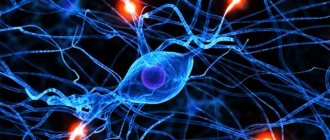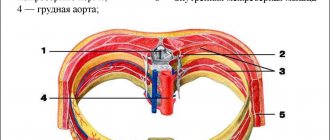The forehead becomes numb because nerves or blood vessels are pinched, or there are serious health problems. There are many possible causes of the pathology. If loss of sensitivity occurs frequently and is accompanied by weakness and pain.
Select the background for which condition you experienced numbness:
- After sleep (23%, 234)
- Inactivity (20%, 204)
- Stress (17%, 178)
- Overwork (13%, 132)
- Alcohol intoxication (12%, 119)
- Lack of sleep (10%, 101 Votes)
- Hypothermia (4%, 37)
- Poor nutrition (1%, 13)
Total voters: 1 018
Loading …
Use search Are you having a problem? Enter “Symptom” or “Name of the disease” into the form, press Enter and you will find out all the treatment for this problem or disease.
Reasons for appearance
There are many reasons why the back of the head may go numb.
They are divided into two types:
- physiological;
- pathological.
Numbness of the back of the head of physiological etiology appears due to the following factors:
- keeping the body and head in one position for a long time (nerve endings are pinched, blood circulation in the vessels of the brain is disrupted);
- incorrect head position during night sleep (too high or no pillow);
- a sharp change in body position in space (dizziness appears along with numbness);
- hypothermia (blood circulation in the vessels is disrupted);
- frequent stress.
The symptom of numbness with the specified physiological factors soon passes, but if numbness is observed for more than 15 minutes, while a person notices such unpleasant phenomena from time to time, this should be a reason to contact a specialist and undergo a diagnosis.
Pathological reasons for the appearance of an unpleasant symptom:
- osteochondrosis;
- increased intracranial pressure;
- hypertension;
- neuralgic diseases;
- multiple sclerosis;
- head injuries;
- pinched nerves;
- neoplasms in the brain;
- impaired blood circulation (thrombosis).
Osteochondrosis of the cervical spine, hypertension, neuralgia and intracranial hypertension in 80% of cases lead to numbness in the back of the head.
Diagnostic methods
Most vascular problems can be detected using Doppler ultrasound.
A complete examination of the patient will help determine the source of the disease and the cause of the symptom. The doctor will perform a visual diagnosis and refer you for tests. The CBC will show iron deficiency anemia and vitamin B12 deficiency, if any.
Using MRI and radiography, you can detect skeletal deformation and other pathologies, due to which the nerve fiber is compressed and numbness in the back of the head occurs. Dopplerography and ultrasound examination will reveal diseases of the vascular system and circulatory disorders in some of the main arteries.
Using electroneuromyography, it is possible to determine the location of damaged nerves. The method also recognizes carpal syndrome and neuropathy.
Depending on your symptoms, other tests may be needed for crown numbness. If there is a history of skull injuries, the patient will be referred to a traumatologist or surgeon. When a sign is noted in the lower part of the head, for example, in the chin area, you need to consult a dentist.
Possible diseases
In medical practice, there are a number of diseases for which the symptom of numbness in the back of the head is specific.
Precursors of stroke in women and men
| Disease | What kind of pathology | Symptoms |
| Osteochondrosis | Pathological changes in the cervical spine, which are characterized by damage to the functions of the intervertebral discs and the transformation of cartilage tissue into bone. Due to pathological changes, pinching of blood vessels and nerves occurs, as a result, blood circulation in the brain is disrupted and innervation to the central nervous system is disrupted. |
|
| Vegetovascular dystonia | The parasympathetic type of work of the central nervous system, in which the blood vessels of the brain periodically narrow or rapidly expand. The disease is characterized by a chronic course, requiring, as a rule, only symptomatic treatment. |
|
| Hypertension | Appears against the background of impaired blood circulation in the vessels of the brain, or against the background of a disturbed psycho-emotional state, as well as with cardiac pathologies. The disease is characterized by a long course and frequent attacks, which often leads to strokes. | High blood pressure is accompanied by a hypertensive crisis (active release of blood from the ventricles of the heart into the blood vessels). Blood rushes to the brain, causing numbness in the occipital region and other parts of the body. The person also feels a sharp headache and throbbing in the temples. |
| Stroke | In this pathological condition, vascular obstruction is noted, which leads to acute disruption of blood circulation in the brain. The pressure in the vessels reaches a maximum and this leads to rupture of the walls of blood vessels and hemorrhages in the brain. | If the attack is not stopped and appropriate measures are not taken, after 2 hours necrosis of the affected parts of the brain is diagnosed. As a result, paralysis of individual limbs or completely one half of the body may occur, voice or hearing may be lost, speech and coordination of movements may be impaired. Stroke often causes death. Associated symptoms:
|
| Atherosclerosis | Formation and deposition of cholesterol plaques in the blood vessels of the brain. By adhering to the walls of blood vessels, they become an obstacle to blood flow, and as a result, blood circulation in the brain is disrupted. If plaques come off, they completely block the patency of the vessels - this leads to an absolute cessation of blood flow to the brain. |
|
| Avitaminosis | Deficiency of B vitamins, as well as microelements such as calcium, magnesium, potassium leads to damage to nerve processes and fibers. |
A light head massage and gymnastic exercises help relieve the condition. |
| Pinched nerves (neuralgia) | The entrapment may involve the trigeminal, facial, maxillary or mandibular nerve. A similar condition occurs against the background of tumor growth, thickening of the walls of blood vessels, and adhesions. |
|
| Multiple sclerosis | An autoimmune chronic disease characterized by the destruction of the membrane of nerve endings, in place of which connective tissue is formed. Replacement with connective tissue can be observed throughout the entire area of the nervous system, forming multiple foci. |
|
| Tumors in the brain | An increase in the size of the tumor leads to pinching of blood vessels, reducing the space of the cranium. The resulting pressure affects the brain tissue and membranes. As a result, brain functioning is impaired. |
|
| Diseases of the musculoskeletal system (in particular the cervical vertebrae) | An unpleasant symptom of numbness occurs after the body and head are in one position for a long time. Pathological changes in the musculoskeletal system lead to disruption of blood circulation in the vessels and hypoesthesia. |
|
| Traumatic brain injury | As a result of injury to the craniocerebral apparatus, problems may arise in various organs and structures of the body. Sometimes symptoms appear immediately, sometimes after 2-3 days. Often such injuries lead to swelling of the brain, the formation of hematomas, and hemorrhages. |
|
Pain and numbness without disease
In medical practice, there are some factors that cause headaches and numbness, but this is not caused by diseases or other abnormalities.
These include certain situations:
- Staying in one position for a long time. If a person remains motionless in the same position for a long time, then the blood circulation in the head is impaired, or rather the blood flow to the head is disrupted, and a pinched nerve can also occur. In addition to pain in the head, it may become numb, but this only appears on a certain side of the face or neck.
- Sleeping in an awkward position. During sleep, the head may be tilted to the side or down, due to this, sensitivity to touch may decrease, and the face may tingle a little. This reaction is normal and the symptoms go away after a short time.
- Abrupt change of position. If you stay in one position for a long time, followed by a quick change, you may become dizzy, become numb, and also experience short-term pain.
The reasons described are normal and often such symptoms are not scary and go away within 10 minutes.
This is due to the fact that the brain must adapt to a normal mode of operation and establish processes.
If normalization does not occur after 10-15 minutes, then the reasons are much more serious and there is a reason to consult a doctor.
Diagnostics
Despite the fact that hypoesthesia of the back of the head is a specific symptom, in order to find out the exact cause of its occurrence, it is necessary to carry out an extensive diagnosis. During the examination, the doctor finds out the presence of previous injuries or previous operations, collects a complete medical history of the patient, and then prescribes a set of diagnostic measures.
This:
- Blood test (clinical, biochemical, for the presence of infections and toxic elements).
- Detailed urine analysis.
- Ultrasound of neck vessels. The condition of the blood vessels of the brain and their patency (blood flow speed and direction) are determined; the study also shows the presence of cholesterol plaques, blood clots, and abnormal bends.
- CT scan of the head. Computed tomography allows you to obtain a layer-by-layer image, in which you can determine in more detail the condition of the brain and blood vessels. The method makes it possible to identify foreign elements, tumor formations, traumatic areas, inflammation of the membranes, hematomas, and hemorrhages.
- MRI of the head. The method provides a three-dimensional image of the brain; all its structures and tissues are displayed on the monitor in three dimensions.
- X-ray of the skull skeleton. Allows you to identify or exclude the possibility of damage to the skeleton of the skull, sinuses and base. The images also show the condition of the soft tissues; significant changes are shown in the images.
Diagnosis and treatment
To conduct a diagnostic test, doctors can use the following methods:
- A full examination is carried out using CG and computed tomography.
- An MRI of the brain and neck is done.
- Neurosonography is performed, which is an ultrasound diagnosis of the head and brain vessels.
- In some cases, an X-ray of the head or neck may be ordered.
Treatment depends on the results of the examination and you need to understand that it cannot always be medicinal.
Among conservative methods, a professional head or neck massage may be required.
After the massage, the blood vessels will expand and the face will no longer go numb.
To reduce headaches, as well as numbness of the head, you should be as careful as possible about your health and control all processes in the body.
To do this, you need to undergo regular examination by a doctor, which should be at least once a year.
It is recommended not to overcool and also avoid drafts.
Normal rest helps a lot, especially if symptoms of fatigue appear.
All diseases, viruses and infections must be treated to the end. Doctors recommend eating right and taking vitamins periodically.
When to see a doctor
The back of the head goes numb (the reasons can be very diverse and dangerous) often due to pathological changes in the brain, so such a condition should cause anxiety in a person and force him to see a doctor.
The regularly recurring symptom of numbness is dangerous; along with the back of the head, the face, neck and other parts of the head can be subject to hypoesthesia. If the condition is accompanied by loss of vision, hearing impairment and high fever, this may mean possible hemorrhages or the formation of hematomas.
The initial examination is carried out by a general practitioner; if necessary, the patient is referred for consultation to other specialized specialists (traumatologist, neurologist, oncologist, vascular surgeon).
A visit to the doctor is required if the following symptoms appear:
- dysfunction of the musculoskeletal system;
- instability, poor coordination of movements when walking;
- feeling of weakness, depression;
- dizziness in the head;
- headache and numbness that do not disappear after taking painkillers;
- rapid increase in body temperature;
- heat in the head;
- hearing, vision, speech impairment;
- problems with urination (incontinence).
The ear goes numb - causes of numbness and what to do in this case - ENT plus
Are you having any problem? Enter “Symptom” or “Name of the disease” into the form, press Enter and you will find out all the treatment for this problem or disease.
↑
Numbness in the ear can be caused by various reasons. More often occurs due to physiological factors:
- Hypothermia, as a result, the earlobes begin to turn pale and cold;
- Lying on your side for a long time, for example, while sleeping;
- After injuries during which the ear was hit.
Loss of sensitivity as a result of physiological factors does not harm health and goes away on its own. It happens that it does not go away for a long time or recurs regularly.
The causes of ear numbness will be:
- Poor circulation, deterioration of blood vessels;
- Osteochondrosis, arthritis, radiculitis, vertebral hernia, vertebral displacement;
- Nerve neuropathy in the facial area;
- Tumors of the brain and other tissues of the head;
- Inflammation in the ear or adjacent tissues;
- Disturbances in the endocrine system.
↑
Left
Numbness in the left or right ear often does not have different symptoms and causes. The left, unlike the right, becomes numb after a mini-stroke and due to heart disease.
Reasons why the left ear becomes stone:
- Micro-stroke or cerebrovascular accident caused by excess weight, heart disease;
- A brain tumor displaces tissue and pinches nerves, accompanied by migraines, blurred vision and dizziness;
- A spinal hernia disrupts the proper functioning of the circulatory system;
- Pinched facial nerve;
- An infectious disease, most often herpes, meningitis;
- Uncontrolled use of potent drugs.
Sometimes the left ear begins to go numb due to unilateral inflammation in the throat or nose.
↑
Right
The causes of numbness in the right are similar to those in the left:
- Tumors of the central nervous system;
- Inflammatory processes in the face area;
- Hypothermia;
- Pinched nerve;
- Problems with the endocrine system;
- Consequences of injury.
The right ear rarely loses sensitivity in diseases of the cardiovascular system. More often, patients complain of numbness on the left side of the body.
↑ https://gidpain.ru/nemeet/ushi-prichina.html
Ears go numb in sleep
Loss of sensation during sleep is a fairly common situation. Unlike other causes, it does not have serious health consequences. It all happens due to sleeping in one position for a long time. Apart from the ear, the entire side of the body begins to become stiff.
Morning exercises will help get rid of the unpleasant feeling of loss of sensitivity. Since blood circulation is delayed during numbness, the blood is first forced to accelerate.
↑
What to do if you feel numb
For physiological pathologies of loss of sensitivity in the ears, it is enough to warm up and do a massage. In case of hypothermia, massage should be done with special warming ointments; you can use traditional medicine recipes. Then wrap your head in a warm towel.
If an unpleasant symptom bothers you for a long time, you need to consult a doctor.
The doctor, after conducting a full examination, will identify the origin of the numbness and prescribe the correct treatment:
- Vascular diseases are treated with medication;
- Inflammatory processes are treated with antibiotics, physiotherapeutic procedures, and in cases of prolonged severe cases, the eardrum is punctured to remove pus;
- To eliminate problems with the spine, complex treatment is carried out: medications, physical therapy and physiotherapy.
Doctors do not advise self-medication; for any disturbing symptoms, seek medical help. Minor unpleasant sensations in the ear area, such as loss of sensitivity, will lead to serious, serious illnesses in humans.
↑
Which doctor should I contact?
The causes of numbness in any area of the head (face, back of the head, right or left side) will be different factors and situations. There is no need to make a diagnosis yourself. To identify the exact causes, you need to contact medical specialists.
The very first doctor to confirm or rule out pathology of the nervous system should be a neurologist. The feeling of numbness is associated with loss of sensitivity, which means that somewhere the passage of electrical impulses along the nerve fiber is disrupted.
Symptoms are sometimes associated with compression of nerves and blood vessels. There is a decrease, sometimes significantly, in the access of nutrients and oxygen to tissues.
The lack of these important elements in a certain area of the muscles and skin creates conditions under which the sensitivity of nerve receptors is disrupted, and a feeling of numbness occurs. It may appear against the background of vascular sclerosis, arterial plaques, or blockage by a detached blood clot.
If a person has been suffering from diabetes for a long time, and part of his head has become numb, the issue should be resolved together with his treating endocrinologist. Regularly elevated blood sugar levels lead to nerve damage, and this can provoke the development of paresthesia.
If trauma is the reason that your head is numb, the first doctor you need to see should be an orthopedic traumatologist. It determines what is damaged in the musculoskeletal system, the extent of the damage, and whether rehabilitation is needed. If necessary, the traumatologist can prescribe a consultation or treatment with a surgeon.
Incorrect bite can be one of the reasons for facial numbness. Deviations from the norm in the bite cause additional stress on the jaw muscles and chewing joints. The facial nerve is compressed and paresthesia develops.
In rare cases, facial paresthesia occurs after tooth extraction when the nerve has been damaged. If this happens, you need to return to the dental surgeon who removed the tooth so that he can prescribe treatment.
If other specialists have not confirmed the presence of pathology in their area, then perhaps the appearance of a feeling of numbness is associated with an infection that has entered the body and affects the nervous tissue. Here you will need to consult an infectious disease specialist.
With a viral or bacterial infection of the middle ear, sinuses, throat, or respiratory tract, inflammation of the trigeminal nerve may occur. Or with meningitis.
There is another disease - Lyme disease (borreliosis), which occurs when a tick bites. The cause will also be any infection, the complications of which may lead to numbness in the head.
If a person has been exposed to chemicals that have led to intoxication of the body, and he has a feeling of numbness, emergency medical care is needed to cleanse the blood of toxins and the help of a toxicologist.
It happens that the effect of toxins on the body lasts for a long time (harmful production or alcoholism). They slowly but surely destroy nervous tissue, which leads to paresthesia.
Sometimes the head can go numb as a result of psychological pressures that are associated with stress. A person does not even notice how he takes a certain position, in which the muscles are overstrained, and they compress the nerves.
Here you will need a consultation with a psychiatrist who will prescribe sedatives, or the help of a good psychologist.
Once again, we list the doctors whose help may be needed to determine the causes of numbness of the scalp:
- Neurologist;
- Vascular surgeon;
- Endocrinologist;
- Traumatologist;
- Dentist;
- Infectious disease physician;
- Immunologist;
- Toxicologist;
- Psychiatrist or psychologist.
It happens that paresthesia occurs due to compression of the spinal cord or brain by various tumor processes. This is done by an oncologist.
↑
The ear goes numb - causes of numbness and what to do in this case 2019
Along with other types of osteochondrosis, cervical osteochondrosis is the most dangerous due to the consequences of circulatory disorders, deterioration of the supply of oxygen and nutrients to the brain. This situation occurs as a result of pinching (compression) of blood vessels and nerves, of which there are many in the cervical region.
Any disease, and osteochondrosis is no exception, is easier to prevent than to treat for a long time. If your ears are blocked or there are unpleasant sensations in the neck, face, or head, then you should not put off visiting a doctor. These seemingly unrelated symptoms may indicate the progression of osteochondrosis.
Prevention of cervical osteochondrosis is an opportunity to avoid many unpleasant and often painful symptoms.
Causes of numbness in the head
The danger is frequent numbness of the head or neck, accompanied by clinical signs such as impaired vision and hearing, as well as increased temperature. In particular, consultation with a neurologist and a comprehensive examination are urgently required for the following symptoms:
- Impaired motor activity;
- Dizziness, unsteadiness of gait, general weakness;
- Involuntary bowel or bladder movement;
- Slurred speech.
Concomitant symptoms are not able to reliably indicate the causes of numbness in the head, so an accurate diagnosis is necessary.
Numbness combined with double vision, poor coordination and general weakness can be caused by the following conditions and diseases:
- Injuries;
- Pinched nerves;
- Multiple sclerosis;
- Poor blood circulation in the brain;
- Brain tumor.
Traumatic brain injuries can result in bleeding into the brain tissue or its lining and require immediate hospitalization. The most dangerous are fractures of the cheekbone, upper jaw and eye sockets. In addition, a concussion can occur as a result of a severe injury. Its symptoms usually subside within a few days.
Source: https://xn--26-9kchf.xn--p1ai/profilaktika/nemeet-uho-prichiny-onemeniya-i-chto-delat-v-dannom-sluchae.html
Prevention
The back of the head goes numb (the causes are often pathological) - this problem has a different nature, on which the treatment tactics and preventive measures taken depend. Prevention will be effective in situations where hypoesthesia is temporary and is not associated with serious pathological disorders of the brain.
To prevent this symptom, doctors recommend:
- constantly monitor the position of the head and neck, as well as tilts when performing any actions (there should be no sudden movements or critical tilt angles);
- if there is a predisposition, monitor blood glucose levels;
- enrich your diet with foods rich in B vitamins (deficiency of this substance leads to the destruction of the membranes of nerve cells and disruption of the electrical conductivity of nerve fibers);
- strengthening muscles with the help of gymnastics (allows you to prevent compression of blood vessels and nerves);
- eliminate bad habits (smoking and alcohol), as toxic substances prevent the enrichment of blood with oxygen and negatively affect the functioning of the central nervous system.
What part of the head is numb?
Depending on which part of the head is numb, you can find out the cause of this phenomenon. If the back of the head goes numb, the reasons for this are mainly external factors. So, when the spinal nerve fibers are pinched, the back of the head goes numb. Colds, high blood pressure, and being in a draft also cause numbness in the back of the head. This happens especially often in the off-season; sudden changes in temperature are the main culprits of the disease.
Stress and hypothermia are common causes of numb scalp.
If the trigeminal nerve is damaged, the head hurts and the face goes numb. This nerve has three branches: orbital, maxillary, mandibular. Numbness of the scalp occurs in different places, depending on which branch is affected.
If the forehead is numb, it is necessary to examine the orbital branch, check the intracranial pressure (perhaps this is intracranial hypertension). Loss of facial skin sensitivity is usually associated with prolonged exposure to one position or pinching of the facial nerve.
Feelings of numbness in the head occur with neuritis, neuralgia, nerve damage as a result of injury or pinching of nerve endings by adhesions, dilated vessels, etc.
Head hypoesthesia can be manifested by such sensations as:
- numbness of the ear, nose, tingling in the eyes;
- pain when touching the forehead, head, or any part of it;
- numbness of the scalp on one side;
Bell's palsy causes inflammation of the facial nerves and is accompanied by pain behind the ears and loss of taste. A good sign is paralysis of only the right side of the head or the left; recovery occurs within a few months.
The consequences of a traumatic brain injury may not appear immediately, but after 1-2 days, and the outcome of such injuries can be unpredictable. In this case, the head, its back, upper (crown), anterior section, neck goes numb, memory deteriorates, and fatigue occurs.
You cannot hesitate in such a situation; consultation with a traumatologist and surgeon is necessary, because displacement of the vertebrae and hemorrhage could occur.
If the feeling of numbness in the head does not go away for a long time and does not disappear when changing position, you should consult a specialist.
Treatment methods
Treatment of the symptom of numbness in the back of the head is carried out depending on the cause that provoked its appearance.
| Cause | Treatment |
| Hypothermia | Rubbing the affected area with herbal solutions infused with alcohol, warming ointment, restoring blood circulation. Wrapping yourself in a woolen scarf. |
| Staying the body and head in one position for a long time | Often the symptom goes away on its own when the person changes his position. A light head massage and a few simple gymnastic exercises will help get rid of it. |
| Multiple sclerosis | Immunotropic therapy and drugs that have a neutrophic and neuroprotective effect are prescribed. The disease, unfortunately, is not curable, and the goal of therapy is to eliminate unpleasant symptoms, relieve new ones, and maintain the patient’s normal well-being. |
| Neoplasms | Radiation and chemotherapy are carried out. If the patient's condition worsens or the tumor begins to progress, surgery is prescribed. |
| Traumatic brain injury | The treatment method depends on the severity of the injuries received. Before the appointment, the patient is diagnosed and the nature of the damage is identified. From the generally accepted treatment model, the patient is advised to rest, dehydration therapy, and take medications that activate the trophism of nerve cells. |
| Osteochondrosis | The patient is prescribed anti-inflammatory and muscle relaxant drugs. He is also indicated for an orthopedic regimen with fixation of the cervical vertebra. During the period of remission, doctors recommend engaging in exercise therapy aimed at strengthening the paravertebral muscles. |
| Hypertensive crisis | In this case, emergency relief of further increases in pressure and symptomatic therapy are required. |
| Impaired circulation of blood flow in the vessels | The condition requires urgent hospitalization and intensive care. |
| Angina pectoris | If there is numbness in the left lobe of the head along with symptoms of heart pain, this may indicate an attack of myocardial ischemia. The patient needs to stop the attack by taking nitroglycerin. If there is no reaction to taking the medication, you should immediately consult a doctor. |
Redness of the face and headache are a sign of a hypertensive crisis
Despite the fact that numbness in the back of the head is a symptom of some pathology, treatment is not only symptomatic. The goal of therapy should be aimed at eliminating the etiological factor (root cause).
Depending on the nature of the disease, the following can be used:
- corsets and bandages for fixing damaged areas of the cervical vertebra;
- warming compresses (for hypothermia);
- therapeutic massages;
- physical and psychological treatment;
- changing lifestyle and daily diet.
Other methods also include:
- acupuncture;
- physical procedures;
- Exercise therapy.
It has been proven that light therapeutic massage improves blood circulation in the brain, resulting in relief of headaches, dizziness, and numbness. You should also not forget about a healthy lifestyle; bad habits disrupt blood flow and contaminate the plasma with toxic substances.
The main reasons are caused by diseases
If the head or one side of it becomes numb, then a slight tingling sensation is felt on the face.
In this case, certain parts of the head may lose sensitivity completely.
Patients in this condition may experience a burning sensation, as well as discomfort during communication.
It happens that a person experiences cerebral paralysis. This disease occurs as a result of damage to the main motor neuron in any area.
Often the cause is a dysfunction of the nervous system. If the left side of the face goes numb, the cause may be a pinched nerve or a disruption in blood circulation.
Perhaps only the back of the head will be at risk. In this case, the reasons are of various kinds, but most often caused by problems with the spine.
In this case, the patient should consult an orthopedist or surgeon, and also have an x-ray taken.
Only after this can the doctor make an accurate diagnosis based on the cause.
As practice shows, every fifth person who has poor sensitivity in the limbs suffers from facial numbness, and there are serious abnormalities or diseases in the body.
Most often, the following factors can be provocateurs:
- Hypothermia.
- Unstable mental state as a result of anxiety and stress.
- Various types of injuries.
When your head hurts and a certain side of it goes numb, additional problems appear, for example, it becomes difficult to swallow or chew.
Patients cannot eat normally because there are problems with chewing food, as well as with swallowing reflexes.
Possible deterioration or loss of taste as a result of dulling of receptors. Some patients complain that only one part of the head, left or right, is numb.
This indicates serious abnormalities, because if the symptom is concentrated in one part of the head, then this is caused by a specific disease, which only a doctor can identify.
Possible complications
The symptom of numbness in the back of the head, if it is not caused by physiological factors, requires urgent medical attention, because it may indicate complex pathological changes in the brain.
The appearance of an alarming sign may indicate the following diseases:
- neuralgia;
- multiple sclerosis;
- hypertension;
- stroke;
- osteochondrosis;
- atherosclerosis;
- tumor neoplasms;
- vegetative-vascular dystonia;
- diseases of the musculoskeletal system;
- traumatic brain injuries.
Many of the diseases accompanied by unpleasant symptoms are quite dangerous and can lead to death. That is why, if a person has long-term and frequent numbness in the back of his head, timely qualified help is required. Treatment of the problem will depend on the cause and nature of the disease. Self-medication is dangerous for the health and life of the patient.
How to treat frontal numbness
Loss of sensation does not always require medical attention. For example, if the cause of the problem is staying in one position for a long time, a cold, stress, depression, wisdom tooth removal, or hypothermia, then there is nothing to worry about.
If the pathology does not go away for a long time, and it is based on a more serious reason, then you cannot do without a trip to a specialist. Such causes include paralysis, vitamin deficiency, meningitis, myocardial infarction, herpes zoster, and fracture.
First, the doctor will diagnose using one of the following methods:
- Blood analysis;
- Radiography;
- Ultrasonography;
- Inspection;
- Palpation of organs;
- Electroneuromyography.
Sometimes it is possible to combine several diagnostic methods.
After the examination, the specialist will determine the cause of the pathology and prescribe the appropriate treatment:
- For multiple sclerosis, medications are prescribed to slow the progression of the disease.
- If the blood supply is impaired, captopril or nifedipine may be prescribed.
- If hypoesthesia is caused by a malignant or benign brain tumor, surgical intervention is resorted to.
- Sometimes decreased sensitivity is treated with massage, acupuncture, and physiotherapy.
- For osteochondrosis, conservative or surgical treatment is used.
- For fractures, plaster is applied.
- Treatment of vitamin deficiency is aimed at replenishing the vitamin deficiency.
- For myositis, physiotherapy, magnetic therapy, physical therapy, and medications are prescribed.
To prevent the recurrence of numbness, you should see a doctor regularly.
What to do if your scalp becomes numb?
If numbness in the back of the head occurs for the first time, or tingling coupled with sharp pain bothers you, rule out cerebrovascular accident or stroke. To do this, call an ambulance.
With hemorrhage in the brain, the pain has a sharp, dagger-like character. The entire back surface of the head becomes numb. Visual disturbances, nausea and vomiting are possible. The latter does not bring any relief.
Osteochondrosis of the cervical spine with severe pain and static-dynamic disorders requires bed rest. A neurologist prescribes adequate pain relief.
For this, Diclofenac, Meloxicam, Voltaren or Nimesil are used. For severe pain, droppers with Novocaine, Baralgin and Analgin are effective. Muscle spasms are relieved by muscle relaxants. Mydocalm injections help better with severe discomfort.
Complements the effect of Pregabalin, Finlepsin. When the condition improves, they begin to inject B vitamins to restore nerve conduction along the myelin fibers. For uncovertebral arthrosis, calcium supplements are prescribed.
The chronic course of chondrosis, the condition after injury, require treatment of the disease with the help of chondroprotective agents. Therapeutic gymnastics and physiotherapy are considered a good help. Swimming strengthens the neck muscles.
If the scalp becomes numb, this means loss of sensitivity. It is necessary to understand exactly what caused this condition. In some cases, this numbness is a symptom of a serious illness.
This condition may be accompanied by a number of unpleasant neurological symptoms: loss of sensitivity and impaired mobility of other parts of the body, problems with speech, dizziness and loss of consciousness, and others.
Why does numbness occur? The reasons can be varied: disruption of the conduction of nerve impulses or blood supply to the skin area, lack of vitamins, infection or damage to the epithelium, pathologies of the central nervous system.
If numbness occurs due to pinched nerves or inflammation, a warm compress can be applied to improve blood flow to the affected area.
In most cases, numbness of the skin on the back of the head, left or right side is caused by compression of the nerve during prolonged exposure to an uncomfortable position. This condition passes quickly and is a normal reaction of the body.
However, if numbness persists for a long time or often recurs, it is necessary to determine the causes of the pathology, since this may indicate various diseases, including serious health problems.
Numbness in any part of the body indicates a loss of sensation in that area. Most often, numbness develops if the blood vessels or nerves innervating the area are pinched.
Other possible causes of numbness:
- mechanical, chemical or thermal damage to the epithelium;
- infectious process in the scalp;
- hypothermia;
- hypo- or avitaminosis D or B12;
- infectious diseases, including colds;
- neurological diseases;
- benign or malignant tumor in the brain;
- microstroke or stroke.
Numbness is a loss of skin sensitivity. Sometimes such numbness is accompanied by tingling, a feeling of pain or impaired mobility not only of the head, but also of other parts of the body.
In some cases, the patient develops dizziness, nausea and headache and other neurological symptoms: speech disturbances, movement, spontaneous urination.
Additional symptoms that accompany this condition depend on why the numbness develops: whether the blood vessels, peripheral nerves, or central nervous system are affected.
If, in parallel with numbness of the scalp, a similar condition develops for the face, impaired mobility of facial muscles and tongue, a possible cause of the pathology is compression of the peripheral nerves.
If neurological symptoms spread throughout the body, then we are talking about pathologies in the central nervous system.
Alarming signs that indicate the presence of a serious pathology:
- numbness is disturbing at rest, and there were no prerequisites for its occurrence;
- numbness is long-lasting and does not go away after applying warm compresses or rubbing;
- unpleasant sensations are asymmetrical (only the right or left side of the head is affected);
- in parallel, numbness of one part of the face develops, immobilization of facial muscles,
- disorders of speech, chewing, swallowing;
- in parallel, visual or hearing acuity decreases;
- headaches or dizziness occur;
- body temperature rises;
- the patient is worried about weakness, lack of appetite, he is losing weight sharply and for no reason.
If all or several symptoms are present, one may suspect that the person's brain is affected. He may have a tumor or a stroke.
To accurately understand the causes of the pathology, a number of diagnostic procedures are performed. They initially contact a neurologist, who makes a preliminary diagnosis based on taking an anamnesis and conducting a series of neurological tests.
For an accurate diagnosis, it is also necessary to undergo a number of studies:
- a laboratory blood test will indicate anemia;
- computed tomography will reveal a possible tumor;
- electroneuromyography - this study allows you to determine which nerve is damaged;
- X-ray examination of the skull and neck will show whether there is displacement of the vertebrae;
- Ultrasound examination of blood vessels to identify circulatory pathology in the vessels of the head.
Treatment
Numbness of the skin of different parts of the head is not a disease, but a symptom that may indicate a serious pathology. The selection of adequate therapy is carried out only after an accurate diagnosis of the disease.
Often, numbness in the back of the head develops due to hypothermia or draft. In this case, inflammation of the peripheral nerves occurs.
To treat this condition, you can use traditional methods of treatment, in particular, rubbing medicinal herbs with alcohol tinctures and warming compresses.
If the cause of numbness in the back of the head or the right or left side of the head is pinched nerves, then it is useful to use massages, rubbing and warming compresses for therapy. However, such treatment can only be applied after an accurate diagnosis has been made.
A warming compress is made from an alcohol tincture of medicinal herbs, diluted 2 times with warm water or their herbal decoctions. To make a compress in a healing potion, moisten a clean cotton cloth, wring it out and apply it to the neck, and wrap it in polyethylene on top.
The outer layer of the compress is cotton wool at least 3 cm thick, which is secured with a bandage. The compress is wrapped on top with a woolen scarf or handkerchief. The patient is advised to remain at rest during the procedure. Compresses are applied daily, optimally before bedtime.
The duration of the procedure is 4–6 hours, but the compress can be left overnight.
Causes of numbness in the back of the head
Numbness of the back of the head and neck is a relatively common complaint of many patients with long-term disorders of the cervical spine. But this sign may indicate more serious illnesses. There are many disorders that cause numbness in the back of the head, so proper examination is required to identify the cause.
Disorders of the cervical spine
Locking of the cervical spine due to contractions of the spinal muscles is among the most common disorders that cause numbness on the left side of the head or the right side.
Typical for this condition is aching pain in the neck when moving the head back and forth and sideways. The pain may radiate to one side of the head or to the forehead.
There is no fever or other symptoms other than headache.
Muscle stiffness and overload are also caused by excessive physical exertion (usually in an untrained person), sleeping in the wrong position, and careless head movements (sudden tilting, rapid rotations).
Osteochondrosis is another part of the body that causes numbness in the head; reasons include degenerative factors, excess weight, genetic predisposition, etc.
This disorder is characterized by a number of unpleasant manifestations: the patient may have pain and numbness in the back of the head, a burning sensation and pins and needles in the back of the head.
Similar manifestations are also typical for rheumatoid arthritis, which affects the cervical spine.
Treatment
Treatment options for vertebrogenic disorders:
- Reflective therapy. Various physical measures are used: heat (not recommended for acute lumbago), skin irritations (ice, cinnamon, pepper gel), massages (acupressure).
- Manipulation of soft tissues. Pressure on myogelosis, treatment of deep fascia.
- Specific methods. Stretching, post-isometric relaxation, anti-gravity methods, positioning, and physical therapy are used.
For rheumatoid arthritis, a number of classes of immunosuppressive drugs are used to suppress the inflammatory process. The classic therapeutic approach is the use of corticosteroids, but these drugs have a number of side effects. A relatively new method is biological therapy, in which drugs that suppress the immune system are given only when needed.
Migraine
If the back of the head goes numb, the reasons may lie in functional disorders of the head joints, typical of classic migraine. These blockages often worsen or even cause attacks. Relief in pain, attack frequency and duration is achieved by addressing the underlying cause.
Migraine affects about 18% of women (including young girls) and 5% of men in Europe. The incidence is shifting to younger and younger age groups.
Sometimes the approach of an attack is signaled in advance by the prodrome phase, which includes a feeling of fatigue, nausea, pressure in the head (in any part - back or front, left or right, on the top of the head). Approximately 20% of patients experience an aura, a visual perception in a certain part of the visual field. They bend, shine, shimmer.
Physical activity worsens the condition; a person seeks silence, peace, darkness and coolness. For some women, migraines are associated with the menstrual cycle. Attacks usually occur at the onset of bleeding, but also appear later or around ovulation.
High pressure
High blood pressure (hypertension) is an insidious disease that may not manifest itself for a long time. In some people, increased pressure is manifested by fatigue, headache (mainly in the frontal or posterior part, in the temples), dizziness, and numbness in the back of the head. Sometimes there is swelling of the face, a feeling of cottony legs that are insensitive to the touch.
Most people have no symptoms. But long-term hypertension causes complications. In particular, it worsens the course of atherosclerosis and related diseases, and over time can cause the development of other diseases, such as:
- coronary heart disease and lower extremities;
- myocardial infarction;
- ischemic stroke;
- narrowing of the renal artery;
- vascular dementia, etc.
When values increase above 230/130, we are talking about a hypertensive crisis, characterized by a high risk of developing various complications.
VSD
Vegetovascular dystonia (VSD) is a clinical diagnosis that combines a number of disorders associated with the functioning of internal organs.
Symptoms of the disease are varied. They appear both separately and in combination with signs of other somatic disorders. A specialized examination is required for correct diagnosis.
A sick person may feel dizzy and have blocked ears. He is often worried about hypotension or hypertension, circulatory disorders (due to narrowing of veins, arteries), numbness of the head, incl. back of the head, indigestion and other problems.
Meningeal syndrome
The left side of the head, its right side or the back of the head also goes numb with meningeal syndrome. Other signs include:
- headache (in particular in the cheekbones);
- nausea;
- vomiting;
- photophobia.
Consciousness, as a rule, is not impaired, only occasionally states of confusion or short-term unconsciousness occur. There is severe rigidity of the upper spine and neck - the patient cannot tilt his head. Paradoxically, the ability to move the head to the sides remains.
In addition to meningitis, meningeal syndrome can occur with subarachnoid hemorrhage and tumor metastases to the brain.
Fever
Increased body temperature (above 38°C) can cause headaches and other symptoms (in particular, with a fever, the scalp becomes numb and stiffness in the back of the head appears). For this reason, it can sometimes be difficult to distinguish a relatively common infection from meningitis.
Causes:
- infectious diseases;
- autoimmune disorders;
- tumor processes;
- increased thyroid function;
- complications of transplantation and transfusion;
- tissue damage;
- intoxication with drugs and other substances;
- heatstroke;
- malignant hyperthermia.








